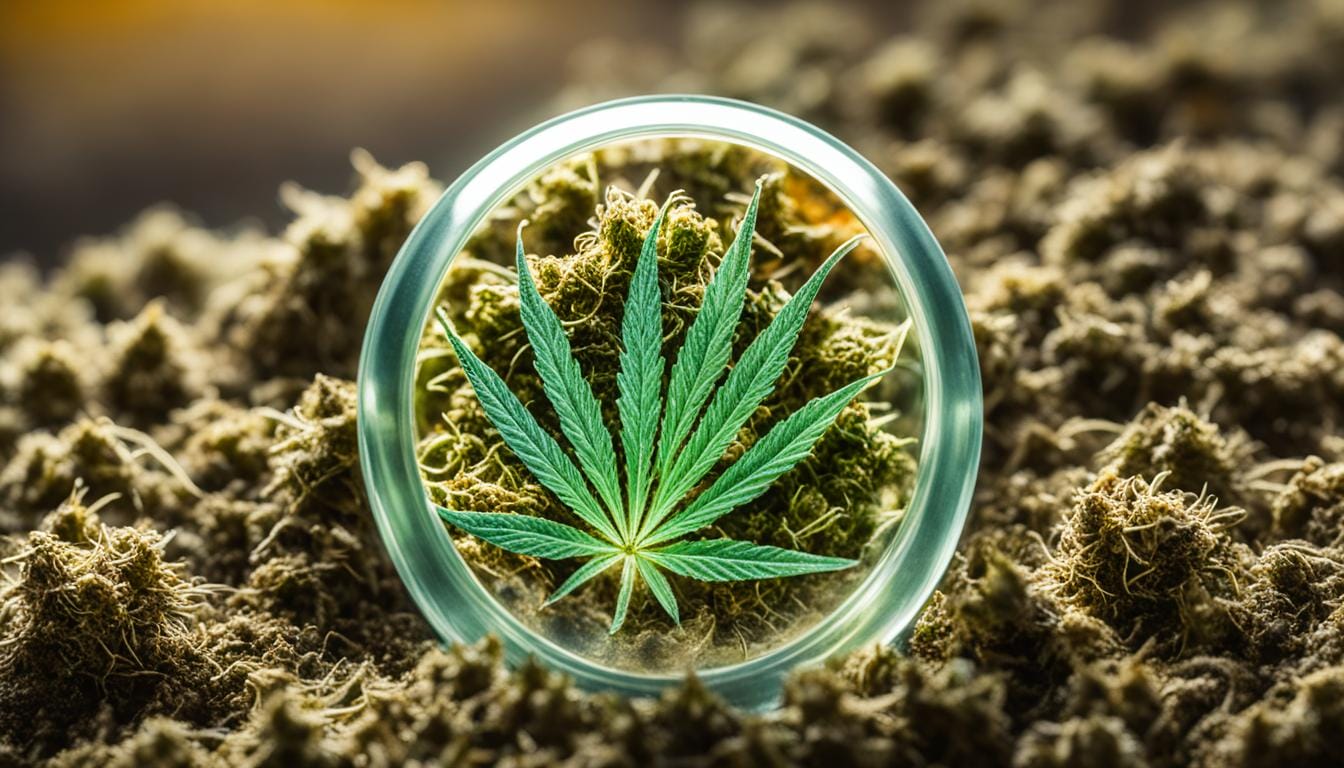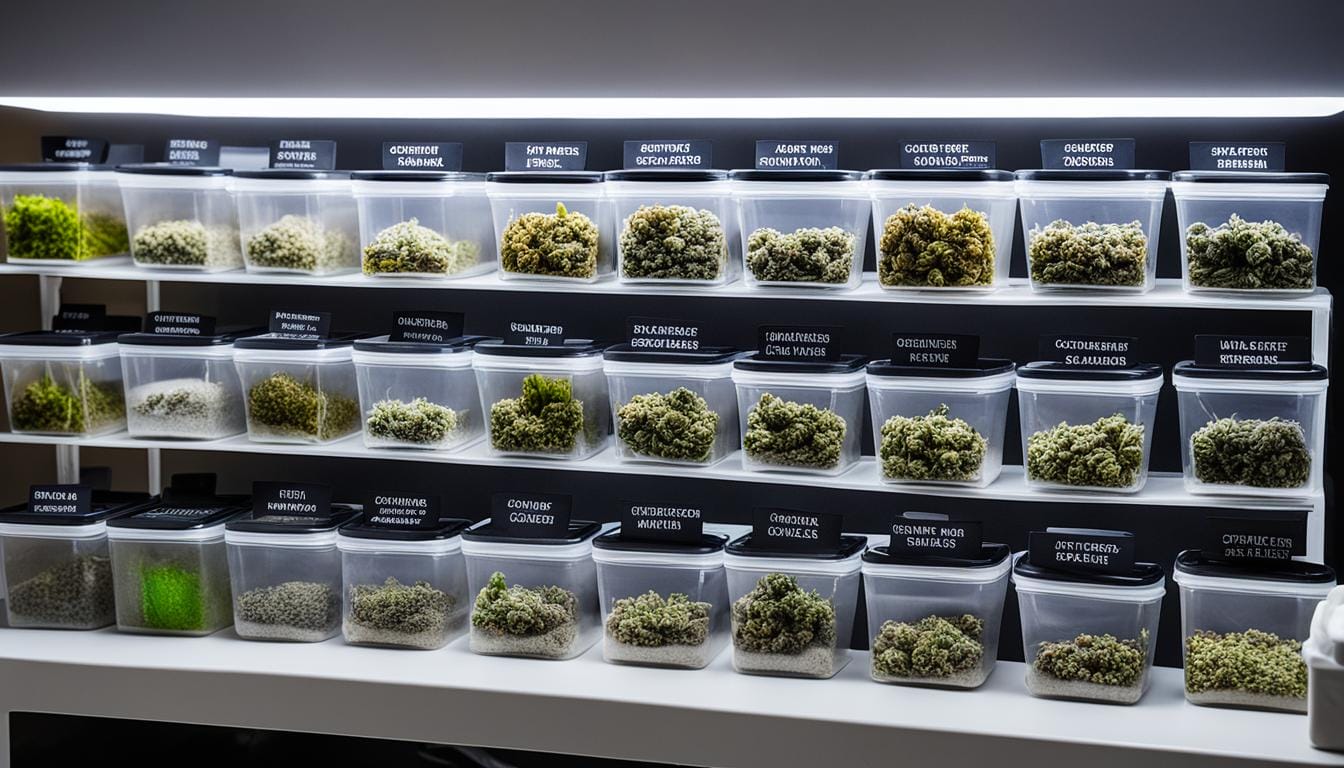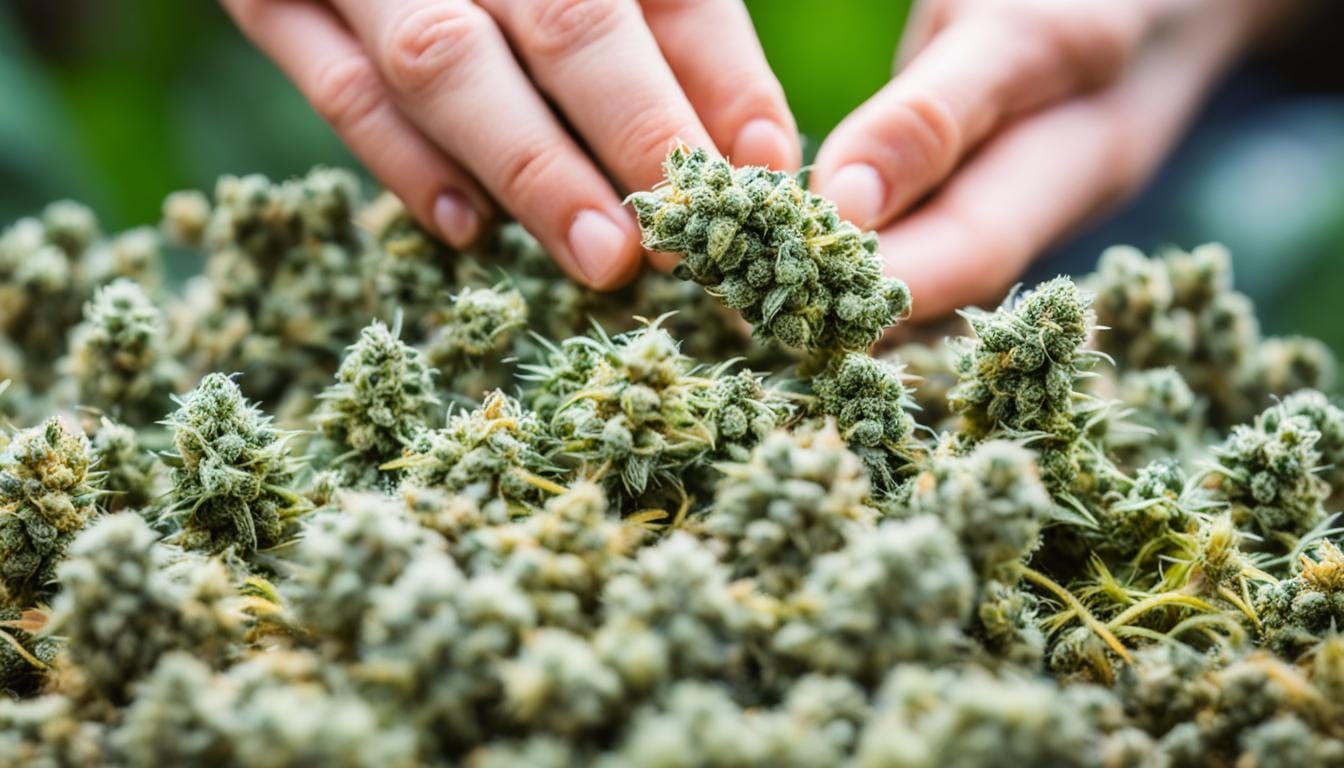Did you know that cannabidiol (CBD), a non-psychotropic cannabinoid found in cannabis, is favored for its therapeutic potential and is being researched for various conditions such as anxiety, depression, MS, and Huntington’s disease? Growing CBD cannabis seeds allows for the cultivation of medical marijuana with low psychotropic effects, making it suitable for consumption throughout the […]
Cannabis Seed to Harvest: Your Complete Guide
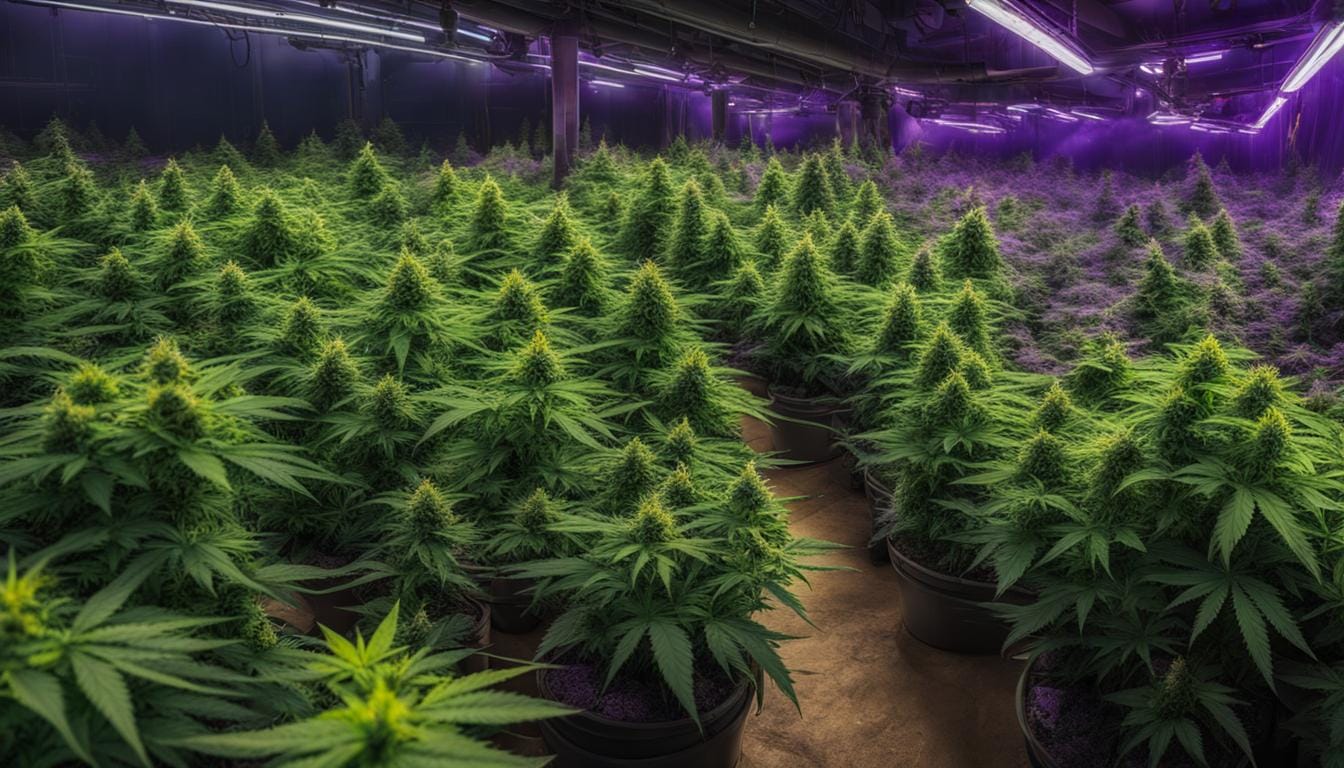
Did you know that cannabis cultivation is a multibillion-dollar industry, with an estimated global market value of over $340 billion by 2027? As the legalization and acceptance of cannabis continue to grow, more and more people are interested in growing their own cannabis plants. Whether it’s for personal use or as a lucrative business venture, learning how to cultivate cannabis from seed to harvest is a valuable skill that can yield both medicinal and financial benefits.
In this comprehensive guide, brought to you by SeedsHereNow.com, we will take you on a journey from cannabis seed to harvest. Whether you’re a beginner or an experienced grower, this guide will provide you with all the information you need to succeed in growing lush cannabis plants. From selecting the right seeds to caring for your plants throughout their lifecycle, we’ve got you covered. Get ready to unlock the secrets of successful cannabis cultivation with our expert tips and techniques.
Key Takeaways:
- Understanding the different types of cannabis seeds and choosing the best option for your needs.
- Exploring the pros and cons of different growing mediums for indoor and outdoor cultivation.
- Nurturing your cannabis seedlings with the right nutrients, watering, and lighting techniques.
- Creating the ideal environmental conditions for vegetative growth and preparing your plants for flowering.
- Maximizing flower yield and quality during the flowering stage through proper light cycles, nutrition, and environmental factors.
Understanding Cannabis Seeds
Before you embark on your cannabis-growing journey, it’s important to understand the different types of cannabis seeds available. From regular seeds to feminized and auto-flowering seeds, we’ll explain the characteristics of each and help you choose the best option for your needs.
When it comes to cannabis cultivation, the right choice of seeds can make all the difference. Let’s take a closer look at the various types:
- Regular Seeds: These are the most common type of cannabis seeds. They have a 50% chance of producing female or male plants. If you’re looking to breed and create your own strains, regular seeds are a great choice.
- Feminized Seeds: Feminized seeds are specially bred to produce only female plants. This ensures that you don’t waste time and resources growing male plants, which do not produce buds. If you’re looking for a guaranteed crop of bud-producing plants, feminized seeds are the way to go.
- Autoflower Seeds: Autoflowering seeds have a unique trait that sets them apart from other seeds. They automatically transition from the vegetative stage to the flowering stage without the need for a specific light cycle. This makes them ideal for growers who want fast and easy harvests.
Choosing the right type of cannabis seeds depends on your goals and growing preferences. Whether you’re a first-time grower or an experienced cultivator, knowing the characteristics of each seed type will help you make an informed decision.
“The right choice of cannabis seeds sets the foundation for a successful and rewarding growing experience.” – Expert Grower
To assist you further in understanding the different types of cannabis seeds, here is a comparison table:
| Seed Type | Characteristics |
|---|---|
| Regular Seeds | 50% chance of producing female or male plants |
| Feminized Seeds | Produces only female plants, ensuring higher bud yields |
| Auto-flowering Seeds | Transitions automatically from vegetative to flowering stage, no specific light cycle required |
Choosing the Right Growing Medium
The choice of the growing medium is crucial for successful cannabis cultivation. Whether you are cultivating indoors or outdoors, selecting the right medium will greatly impact the overall health and growth of your cannabis plants. In this section, we will explore the pros and cons of different mediums, including soil, hydroponics, and coco coir, helping you make an informed decision for your specific needs.
Soil: The Natural Choice
When it comes to growing cannabis, traditional soil remains a popular choice among cultivators. Its organic composition provides essential nutrients and beneficial microorganisms that support healthy plant growth. Soil is forgiving and suitable for beginner growers, requiring minimal maintenance and providing good water retention. However, it is essential to choose high-quality soil and monitor pH levels to ensure optimal plant health.
Hydroponics: Precision and Efficiency
If you prefer a more controlled environment and faster growth, hydroponics may be the right choice for you. Hydroponic systems utilize water and nutrient solutions, allowing the roots to directly absorb the necessary elements. This method eliminates the need for soil and minimizes the risk of pests and diseases. However, hydroponics requires careful monitoring of pH and nutrient levels to avoid imbalances that could harm your plants.
Coco Coir: The Versatile Alternative
Coco coir, made from coconut husks, offers a versatile and environmentally friendly growing medium. It has excellent water retention capabilities while providing ample oxygenation to the roots. Coco coir is known for its ability to retain nutrients and maintain a stable pH level, resulting in faster growth and higher yields. However, it requires specific nutrient management to prevent nutrient lockout.
Tip: Consider the specific needs of your growing environment, such as space, available resources, and desired level of control, when choosing your growing medium. It’s also worth experimenting with different mediums to find the one that suits your growing style and delivers optimal results.
Now that you have a better understanding of the different growing mediums available, you can make an informed decision based on your preferences and growing goals. Remember, each medium has its advantages and considerations, so choose the one that aligns with your cannabis growing tips, be it indoor cultivation or nurturing outdoor cannabis plants.
Nurturing Your Cannabis Seedlings
Once your cannabis seeds have germinated, it’s time to provide the care and nourishment your seedlings need to thrive. Proper nurturing during this critical stage will set the foundation for healthy and vigorous plants. In this section, we’ll explore the best nutrients for cannabis and the essential care techniques to ensure optimal growth.
1. Essential Nutrients: Cannabis plants require a balanced diet of nutrients to grow strong and healthy. Key nutrients include nitrogen (N), phosphorus (P), and potassium (K), as well as secondary nutrients like calcium (Ca), magnesium (Mg), and sulfur (S). Additionally, micronutrients such as iron (Fe), manganese (Mn), zinc (Zn), and others are crucial for proper plant development. Using a high-quality nutrient solution specifically formulated for cannabis will help provide these essential elements in the correct ratios.
2. Feeding Schedule: It’s important to follow a feeding schedule that matches the specific growth stage of your seedlings. During the early vegetative stage, when seedlings have just established their first true leaves, start with a nutrient solution that is low in concentration. Gradually increase the strength of the solution as the plants grow and develop more leaves. During the late vegetative stage, the nutrient concentration can be further increased to support healthy root and foliage growth.
3. Proper Watering: Overwatering can lead to root rot and other plant health issues, while underwatering can cause stunted growth and nutrient deficiencies. Monitor the moisture level of the growing medium by sticking your finger about an inch deep into the soil. If it feels dry, it’s time to water. It’s important to strike a balance and ensure the growing medium is evenly moist, allowing oxygen to reach the roots. Avoid overwatering by providing drainage and letting excess water escape.
4. Optimal Lighting: During the seedling stage, providing the right amount and quality of light is crucial for healthy growth. Seedlings require a light source rich in blue light wavelengths to promote compact and sturdy growth. Fluorescent lights, like T5 or CFL bulbs, are ideal for this stage. Position the lights about 2-4 inches above the seedlings and provide them with 18-24 hours of light per day. Maintaining the proper light distance and duration will prevent seedlings from getting leggy or burned.
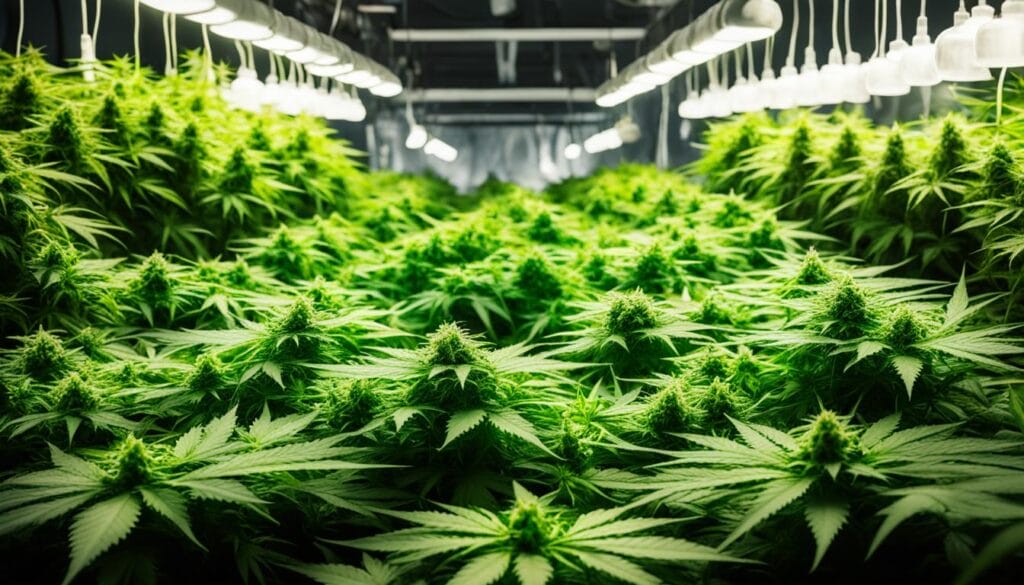
“Proper nourishment and care during the seedling stage are critical for the long-term health and productivity of your cannabis plants.”
Table: Essential Nutrients for Cannabis Seedlings
| Nutrient | Function | Deficiency Symptoms |
|---|---|---|
| Nitrogen (N) | Stimulates leaf and stem growth | Pale and yellowing leaves |
| Phosphorus (P) | Promotes root development and flower production | Purple or dark leaves, weak stems |
| Potassium (K) | Aids in overall plant health and disease resistance | Yellowing edges and tips of leaves |
| Calcium (Ca) | Strengthens cell walls and prevents nutrient uptake issues | Blossom end rot, stunted growth |
| Magnesium (Mg) | Essential component of chlorophyll for photosynthesis | Interveinal chlorosis (yellowing between leaf veins) |
| Sulfur (S) | Required for protein synthesis and enzyme activation | Pale leaves, stunted growth |
Remember, each cannabis strain may have specific nutrient requirements, so it’s essential to adjust the feeding regimen based on the plants’ response and any signs of nutrient deficiencies or excesses.
Now that your cannabis seedlings are receiving the best nutrients and care, they will be well-prepared for the next stage of growth. In Section 5: Vegetative Growth: The Foundation for Healthy Plants, we will guide you through providing the optimum environmental conditions to promote robust vegetative growth.
Vegetative Growth: The Foundation for Healthy Plants
The vegetative stage is vital for the overall development of cannabis plants. During this phase, your plants focus on vegetative growth, establishing a strong foundation for healthy and robust plants. To ensure successful vegetative growth, it is essential to provide the ideal environmental conditions for your cannabis plants.
Temperature: Keep the temperature within the range of 70-85°F (21-29°C) during the vegetative stage. This range promotes optimal growth and minimizes the risk of stress-related issues.
Humidity: Maintain a moderate humidity level between 40-60% to prevent mold and fungal growth. Proper ventilation helps regulate humidity levels and ensures adequate airflow for your plants.
Air Circulation: Proper air circulation is crucial for healthy plant growth. Use fans to improve air movement and strengthen the stems of your cannabis plants. This will help prevent issues such as mold, mildew, and insect infestations.
Throughout the vegetative stage, your plants will appreciate a nutrient-rich soil or a well-balanced hydroponic solution. Regularly monitor and adjust the pH level of the growing medium to ensure optimal nutrient uptake.
Remember to check your cannabis plants regularly for signs of nutrient deficiencies or other issues. Healthy vegetative growth sets the stage for an abundant flowering phase, where your plants will produce those coveted buds.
“Proper environmental conditions during the vegetative stage contribute to robust plant development and result in healthy cannabis plants ready for the flowering stage.”
| Environmental Factors | Optimal Range |
|---|---|
| Temperature | 70-85°F (21-29°C) |
| Humidity | 40-60% |
| Air Circulation | Proper ventilation and fans for airflow |
By adhering to these cultivation techniques and providing the ideal environment, you are setting the stage for a successful cannabis cultivation journey. In the next section, we’ll dive into the flowering stage, where those beautiful buds begin to form.
Flowering Stage: Buds in the Making
The flowering stage is a crucial phase in cannabis cultivation where your plants transition from vegetative growth to the production of beautiful, resinous buds. Understanding the essential techniques and considerations during this stage is key to achieving a bountiful harvest. Let’s explore the marijuana growing essentials and cannabis cultivation techniques that will help you maximize your flower yield and quality.
The Importance of Light Cycles
Proper lighting is vital during the flowering stage as it mimics the changing seasons and triggers the plants to enter the reproductive phase. Most cannabis strains require a shift in light cycles, typically from 18 hours of light and 6 hours of darkness to 12 hours of light and 12 hours of darkness. This change signals the plants to start producing buds. Maintaining consistent and appropriate light cycles throughout the flowering stage is crucial for optimal bud development.
Optimizing Nutritional Balance
During the flowering stage, cannabis plants have specific nutrient requirements to support bud formation and growth. Increase the levels of potassium and phosphorus in your nutrient regimen, as these nutrients play a vital role in bud development. However, be mindful of not overfeeding your plants, as it can lead to nutrient lockouts or burn. Monitoring the pH of the nutrient solution is also essential to ensure proper nutrient absorption.
Environmental Factors for Bud Development
Environmental conditions greatly influence the size, density, and overall quality of cannabis buds. Here are a few crucial factors to consider:
- Temperature: Maintain temperatures between 65-80°F (18-27°C) during the daytime and slightly cooler at night to avoid stress and excessive humidity.
- Humidity: Keep humidity levels between 40-50% to prevent mold and mildew while still providing enough moisture for healthy plant growth.
- Air Circulation: Good air circulation is vital to prevent stagnant air and promote healthy growth. Use oscillating fans to ensure proper airflow, reducing the risk of pests and diseases.
Techniques Used by Experienced Growers
Experienced growers have honed their skills and developed techniques to optimize bud production during the flowering stage. Some common techniques include:
- Strain Selection: Choosing strains known for heavy bud production can greatly impact your overall yields.
- Defoliation: Proper defoliation techniques involve selectively removing some of the fan leaves to allow light penetration and improve air circulation, promoting bud growth.
- Topping and Pruning: Topping and pruning techniques help encourage lateral growth, resulting in more bud sites and higher yields.
| Technique | Description |
|---|---|
| Supercropping | This technique involves strategically damaging the main stem or branches to increase the overall strength and support of the plant, resulting in larger buds. |
| Scrogging | Screen of Green (SCROG) technique involves placing a screen or net above the plants and training the branches to grow horizontally, optimizing light exposure and increasing bud sites. |
| Lollipopping | Lollipopping focuses on removing lower branches and foliage, directing the plant’s energy towards the top canopy and enhancing the development of larger, more potent buds. |
The combination of proper lighting, optimal nutrition, and meticulous environmental control, along with the use of advanced techniques, can help you achieve bumper harvests during the flowering stage. Experiment with different methods and fine-tune your approach to find what works best for your specific strain and growing conditions.
Harvesting and Curing Marijuana Buds
Congratulations! It’s time to reap the rewards of your hard work. After months of diligent care, you’re finally ready to harvest and cure your marijuana buds for the ultimate experience. In this section, we’ll provide you with step-by-step guidance on how to achieve maximum potency, flavor, and aroma in your harvest. Let’s dive in!
Knowing When to Harvest
The key to a successful harvest lies in picking the right moment. Harvesting too early can lead to underdeveloped buds, while waiting too long may result in decreased potency. To determine the optimal time for harvest, keep an eye on the trichomes, the tiny resinous glands on the buds.
When the trichomes transition from clear to cloudy or amber, it’s a sign that the buds are ready to be harvested. Use a magnifying lens to inspect the trichomes closely, as this will help you make an accurate assessment.
Expert Tip: Harvesting during the “full cloudy” stage will give you a more uplifting and cerebral high, while waiting until some trichomes turn amber will produce a more relaxing and sedative effect.
The Harvest Process
Once you’ve determined that it’s time to harvest, follow these steps to ensure a successful and bountiful harvest:
- Carefully cut the main stem of each plant using clean pruning shears.
- Remove any large fan leaves to facilitate better airflow during the drying process.
- Hang the plants upside down in a cool, dark, and well-ventilated area where humidity levels are around 50-60%. This will prevent mold and mildew formation.
- Allow the plants to dry for approximately 7-14 days until the smaller stems snap instead of bending.
The Curing Process
After the initial drying phase, it’s crucial to cure your buds properly. Curing not only enhances the flavor and aroma but also improves the overall smoking experience. Follow these steps to achieve a top-quality product:
- Trim the buds from the stem and place them in glass jars, filling them up to about 75% capacity.
- Seal the jars and store them in a cool, dark place, away from direct light or heat sources.
- During the first week, open the jars once or twice a day to allow the excess moisture to escape. This process, known as “burping,” prevents mold growth.
- Continue curing for at least 2-4 weeks, opening the jars less frequently as the buds cure and the moisture content stabilizes.
By following these harvesting and curing techniques, you’ll ensure that your marijuana buds deliver the best possible experience. The patience and care you put into this final stage of the cultivation process will be rewarded with potent, flavorful, and aromatic buds that can be enjoyed for months to come.
Troubleshooting Common Growing Issues
Even experienced growers encounter challenges during the cultivation process. Don’t worry, we’ve got you covered! In this section, we’ll address the most common growing issues that may arise with your cannabis plants. From pests and diseases to nutrient deficiencies and environmental stress, we’ll provide you with effective solutions to safeguard the health of your plants.
Pests
Pests can wreak havoc on your cannabis plants, causing damage and affecting their growth. Here are some common pests you may encounter:
| Pest | Symptoms | Solutions |
|---|---|---|
| Aphids | Yellowing leaves, curled leaves | Use insecticidal soap or neem oil |
| Spider Mites | Webbing, yellow spots on leaves | Introduce beneficial insects like ladybugs |
| Whiteflies | White, powdery substance on leaves | Set up yellow sticky traps |
Diseases
Plant diseases can quickly spread and compromise the health of your cannabis plants. Here are some common diseases to watch out for:
- Botrytis (Gray Mold): Grayish mold on buds and leaves. Remove affected parts and improve ventilation.
- Powdery Mildew: White powdery substance on leaves. Apply a fungicidal spray and maintain proper airflow.
- Root Rot: Wilting, yellowing leaves. Improve drainage and avoid overwatering.
Nutrient Deficiencies
Proper nutrition is essential for healthy cannabis plants. Here are some common nutrient deficiencies and their symptoms:
| Nutrient | Symptoms | Solutions |
|---|---|---|
| Nitrogen | Yellowing leaves, stunted growth | Apply a nitrogen-rich fertilizer |
| Phosphorus | Purple stems, slow growth | Use a phosphorus-heavy fertilizer |
| Potassium | Brown spots, weak stems | Increase potassium intake with a fertilizer |
Environmental Stress
Environmental factors can also impact your cannabis plants’ health and growth. Here are some common environmental stressors and how to mitigate them:
- Temperature Fluctuations: Keep your grow room or outdoor environment within the optimal temperature range for your plants.
- Humidity Imbalances: Maintain proper humidity levels according to the stage of growth.
- Lighting Issues: Ensure your plants receive the correct amount and intensity of light.
By understanding and addressing these common growing issues, you can ensure the well-being of your cannabis plants and achieve successful cultivation. Remember, a healthy plant is a happy plant!
Advanced Growing Techniques
Ready to elevate your cannabis cultivation skills? Take your marijuana growing to the next level with advanced techniques that can optimize plant health and maximize yields. Seasoned growers rely on these tried-and-true methods to achieve exceptional results.
Pruning
Pruning involves selectively removing certain parts of the plant, such as leaves and branches, to promote optimal growth and development. By strategically trimming away unnecessary foliage, you can redirect the plant’s energy towards bud production and improve airflow, reducing the risk of mold and disease. Regular pruning also helps maintain the plant’s shape and size, making it more manageable and facilitating light penetration to lower canopy areas.
Training
Training techniques, such as low-stress training (LST) and screen of green (SCROG), help manipulate the plant’s growth pattern to maximize light exposure and bud development. LST involves gently bending and securing branches to expose more budding sites to light, resulting in larger and denser buds. SCROG, on the other hand, involves weaving the plant through a horizontal screen, ensuring an even canopy and promoting uniform bud growth.
Supplemental CO2
Carbon dioxide (CO2) is essential for photosynthesis, the process by which plants convert light into energy. Adding supplemental CO2 can significantly boost plant growth and flower production, especially in enclosed grow spaces where carbon dioxide levels can become depleted. However, it’s essential to monitor and control CO2 levels carefully, as excessive amounts can harm the plants. Consult with experienced growers or research guidelines to ensure you maintain the optimal CO2 concentration for your specific setup.
| Advanced Growing Techniques | Benefits |
|---|---|
| Pruning |
|
| Training |
|
| Supplemental CO2 |
|
Storing Cannabis Seeds and Genetic Preservation
When it comes to cannabis cultivation, proper storage of your precious seeds is essential to maintain their viability and genetic integrity. By following the best practices for storing pot seeds and weed seeds, you can ensure that your favorite strains are preserved for future grows and protect your investment in premium genetics.
Here are some cannabis growing tips to help you store your seeds effectively:
1. Keep Seeds in a Cool and Dark Environment
Exposure to heat, moisture, and light can degrade the quality of cannabis seeds over time. It’s crucial to store your seeds in a cool and dark environment to maintain their viability. Consider investing in airtight containers or seed banks that provide a dark and temperature-controlled space for your seeds.
2. Use Moisture-Control Methods
Excessive moisture can lead to mold or seed degradation. To prevent this, use moisture-control methods such as adding desiccant packs or silica gel packets to your seed storage containers. These packs help absorb excess moisture and maintain the optimal humidity level for seed preservation.
3. Label and Organize
Proper labeling and organization are crucial when storing multiple strains or batches of seeds. Use clear labels to identify the strain, date of acquisition, and any other relevant information. This will make it easier for you to locate and track your seeds for future use.
4. Avoid Frequent Temperature Fluctuations
Temperature fluctuations can negatively impact seed viability. Avoid subjecting your stored seeds to frequent temperature changes. Ideally, store them in a place with a consistent temperature, away from sources of heat or cold.
5. Regularly Check for Viability
Over time, seed viability may naturally decrease. To ensure that your stored seeds are still viable, it’s recommended to test germination rates periodically. This can be done by sprouting a few seeds every few months to assess their viability. Discard any seeds that fail to germinate.
6. Consider Genetic Preservation Techniques
If you have a particularly valuable or rare strain, you may want to consider genetic preservation techniques such as seed cloning or tissue culture. These methods can help preserve the genetics of your favorite strains for future use, even if the stored seeds lose their viability.
By following these cannabis-growing tips for storing your pot seeds and weed seeds, you can ensure that your collection remains viable and ready for future cultivation endeavors.
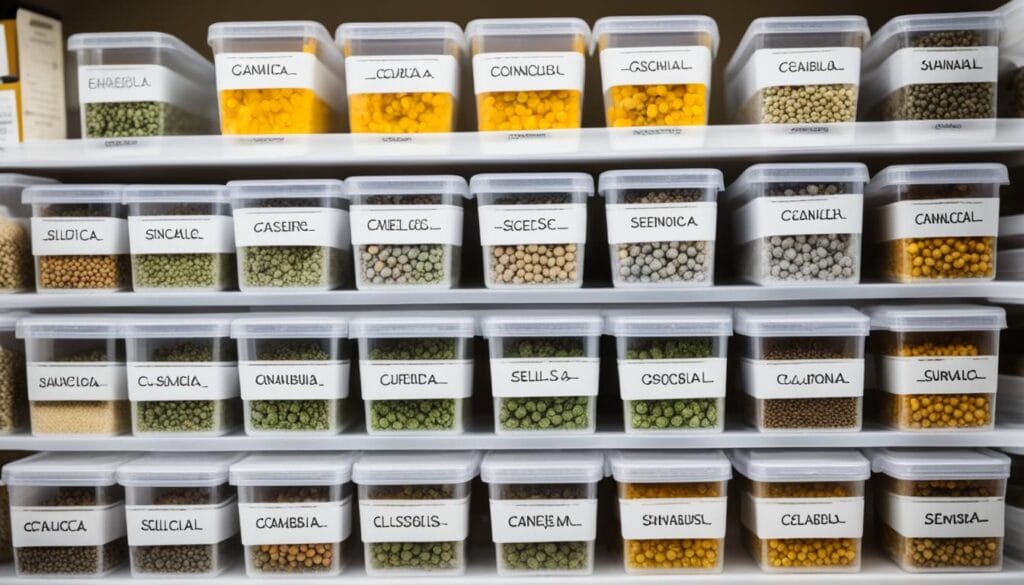
Legal Considerations for Growing Cannabis
When it comes to cultivating cannabis, it’s crucial to understand the legal landscape in your area. Laws surrounding cannabis cultivation can vary from state to state, so it’s essential to familiarize yourself with the regulations and restrictions specific to your location. By doing so, you can ensure that you cultivate responsibly and within the confines of the law.
Whether you’re growing for personal use or as a licensed cannabis producer, staying informed about the legal aspects of growing cannabis is key. Here are a few important points to consider:
- Research Local Laws: Start by researching the laws specific to your state or region. Look into the requirements for obtaining licenses, permits, or registrations if applicable. Understanding the legal framework around cannabis cultivation will help you navigate the process more effectively.
- Comply with Quantity Restrictions: Depending on where you live, there may be limitations on the number of plants you can grow or the amount of cannabis you can possess. Ensure that you stay within the legal limits to avoid any legal consequences.
- Respect Zoning Regulations: Many jurisdictions have zoning regulations that dictate where cannabis cultivation is permitted. Make sure you are aware of any zoning restrictions in your area to avoid potential conflicts with local authorities.
- Observe Security Measures: Cannabis cultivation often involves valuable plants, which may make your cultivation site a target for theft. Be sure to take appropriate security measures, such as installing security systems, proper lighting, and secure fencing, to safeguard your plants as well as your compliance with the law.
- Stay Updated on Legal Changes: As the legal landscape surrounding cannabis continues to evolve, it’s crucial to stay updated on any changes or amendments to the laws in your area. Joining local cannabis associations or following reputable industry news sources can help you stay informed.
By understanding and adhering to the legal considerations for cannabis cultivation, you can ensure a smooth and compliant growing experience. Remember, compliance is not only essential for avoiding legal issues but also for contributing to the overall acceptance and normalization of cannabis cultivation.
Conclusion
Congratulations on completing our comprehensive guide to growing cannabis from seed to harvest. With the knowledge and tips provided, you’re now equipped to embark on a successful cannabis cultivation journey. Remember, the key to thriving plants is to prioritize their well-being and provide them with the care they need.
As you nurture your cannabis plants, enjoy the rewarding experience of watching them grow and flourish. Don’t forget to savor the final product and the joy it brings. Growing your own cannabis not only gives you a sense of achievement but also allows you to have full control over the quality and variety of strains you consume.
Whether you’re an experienced grower looking to refine your techniques or a beginner taking your first steps in the world of cannabis cultivation, we hope this guide has provided you with the information and inspiration you need. Happy growing!
Now that you understand the cultivation process from seed to harvest, shop the collection of regular, feminized, and autoflower cannabis seeds at Seeds Here Now.
FAQ
What types of cannabis seeds are available?
What are the pros and cons of different growing mediums?
What nutrients do cannabis plants need?
How can I maximize flower yield during the flowering stage?
When is the best time to harvest marijuana buds?
How do I store cannabis seeds properly?
Are there any legal considerations for growing cannabis?
Back

